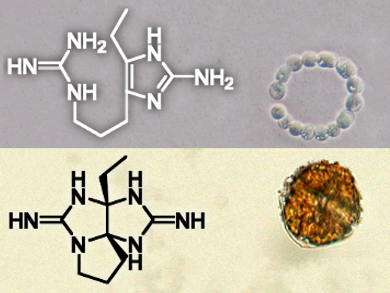Saxitoxin (STX), the most potent and selective voltage-gated sodium channel blocker known, is one of a family of paralytic shellfish toxins (PSTs) that can potentially cause serious food poisoning when ingested. However, STX has attracted the attention of synthetic chemists because of its high biological activity and unique bisguanidine tricyclic structure. Different pathways have been proposed for the biosynthesis of STX, but have not yet been verified experimentally, and the reaction mechanism for the construction of the tricyclic ring of STX remains unknown.
Mari Yotsu-Yamashita and co-workers, Tohoku University and Tokyo University of Agriculture and Technology, Japan, have converted Int-C’2 (pictured, top), a biosynthetic intermediate of STX, into a tricyclic bisguanidine compound, Cyclic-C’ (pictured, bottom), through an oxidative cyclization method catalyzed by Pd/C under basic conditions.
Using HPLC–MS (high pressure liquid chromatography coupled with mass spectrometry), they were able to identify the presence of Cyclic-C’ in PST-producing microorganisms, suggesting the possibility that this compound is involved in the biosynthesis of PSTs. This finding could be a step towards determining the complete biosynthetic pathway of STX.
- Synthesis of a Tricyclic Bisguanidine Compound Structurally Related to Saxitoxin and its Identification in Paralytic Shellfish Toxin-Producing Microorganisms,
Shigeki Tsuchiya, Yuko Cho, Keiichi Konoki, Kazuo Nagasawa, Yasukatsu Oshima, Mari Yotsu-Yamashita,
Chem. Eur. J. 2015.
DOI: 10.1002/chem.201500064




